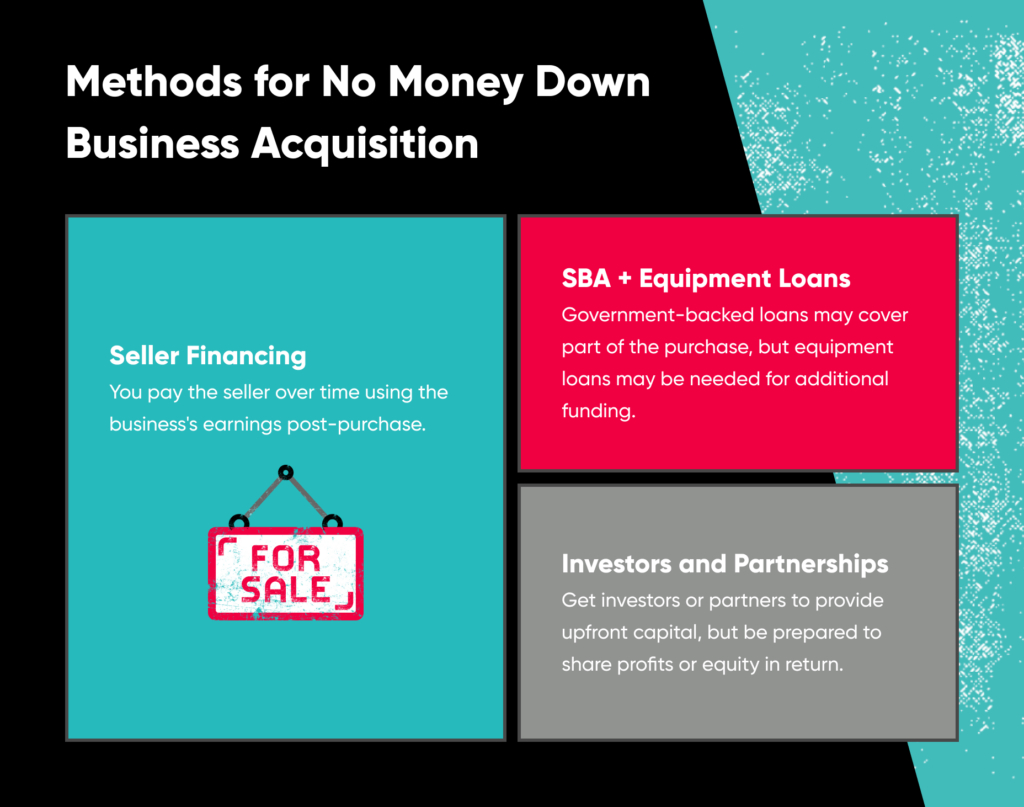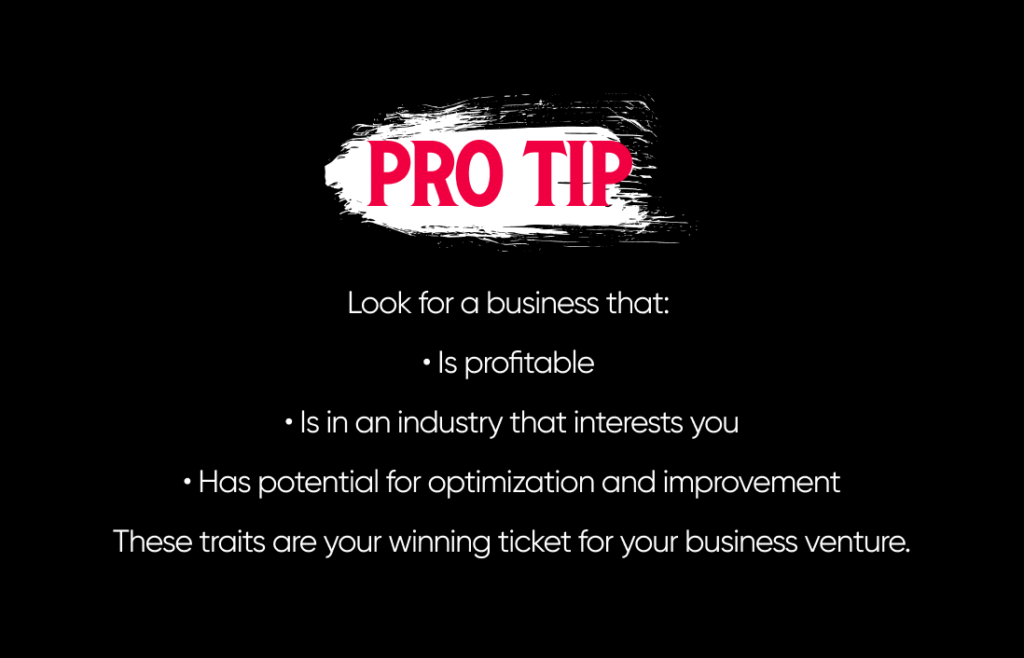
Up to 90% of Americans want to be their own boss.
Owning a business that brings in consistent revenue is a dream for many Americans. Plenty of people see it as a path to freedom and financial security.
But the reality of buying a business is that it’s straight-up hard work.
And it may seem out of reach if you’re strapped for cash. If you don’t have the funds to put money down for a business loan, you’re out of luck.
Or so the conventional wisdom goes.
You can buy a business with no money down.
It’s a Contrarian approach that takes time, research, and an investment in your own negotiation skills. But it happens all the time. Here’s what you need to know to get started.
Can You Really Buy a Business Without Using Your Own Money?
TLDR: Yes, you can buy a business without using your own money.
First of all, Baby Boomers are retiring en masse.
Tons of them own businesses and several are cheap businesses to buy. So the supply of businesses on the market? It’s about to start growing.
Then consider that only 30-40% of businesses on the market ever sell.
That means the supply is greater than the demand, putting you in a position to pick and choose the perfect business.
And the fact that most businesses don’t sell isn’t the only thing putting pressure on owners. There are so many other reasons an owner wants out.
Here are the most common reasons for business owner exit (AKA the 5 D’s of buy-sell agreements):
- Disability
- Divorce
- Departure
- Dissolution
- Death
But those are just the tip of the iceberg. There’s also:
- Being burned out
- Caregiving for child, parent, or other family member and needing more flexibility
- Wanting to pursue something new or retire
- Lack of passion for the company or offering
- Taking time to travel or spend with family
A business owner facing any of these issues or opportunities is motivated to sell, even if the buyer doesn’t have cash in hand.
For you as the buyer, all it takes is some research and negotiation skills to do a no-money deal.
Multiple financing options to purchase a business exist for putting in no cash to close deals, but some are less valuable than others. For example, pay on performance or shares only can work, but they’re also risky.

Instead, check out methods like:
- SBA loans and equipment loans
- Investors and partnerships
- Seller financing
SBA Loans + Equipment Loans
Most people have heard of SBA loans, but they’re not actually given to you by an “SBA bank.”
Instead, the government backs a good portion of a loan from another lender. SBA loans have an edge over traditional bank loans for this very reason.
Government backing makes the lender more likely to approve you. That means you stand a better chance of getting your foot in the door with a business.
But both you and the business have to meet some criteria to qualify for an SBA loan. You’ll need a ton of financial documentation and a more-than-fair credit score.
And there’s 1 other issue with the SBA loans.
The government will only authorize you for up to 90% of the business’s value. That’s the max, too. The SBA might require you to kick in up to 30%.
So you’re more than likely going to need cash from some other source.
One option is to use an equipment loan to cover the parts of the business that the SBA won’t cover.
But that introduces more red tape from the bank giving you the equipment loan. And getting the equipment loan without any of your own money is a bit of a longshot.
If taking on that much debt feels like too much for you, or you just don’t want the complexity of applying for multiple loans, look into other no-money-down options.
Investors and Partnerships
You don’t have money.
Other people do.
Simple enough solution: Bring in partners and investors.
By convincing others of the opportunity, you get some money upfront to buy the business. But you now have to appease these investors.
Oh yeah, and pay them back or give them an equity stake, depending on the deal you strike. In some cases, you may even end up with a silent partner who draws an income after contributing the initial cash and nothing else.
Long story short, raising capital gets you the money you need but has a long-term downside.
And that’s if you know anybody who could or would invest with you.
Most people don’t have the network to meet the kinds of people willing to put their cash on the line for your idea or business plan. You can start building up your network now, but that’s a long route to buying your business.
Seller Financing
We saved the best for last.
Shameless plug: this one is our favorite financing option at Contrarian Thinking. It’s used by a ton of our Contrarian Community members.
When you are buying a business with seller financing, you agree with the seller on an amount of money to put down. You also agree on a payback period that stretches over weeks, months, or years.
Where does the money come from? The revenue from the business after you take over.
In this case, the seller is the bank. You can propose terms that work for you and negotiate from there.
You’ll often get a much more flexible deal than you would through any of the other options.
While the SBA leaves you with 10-30% to come up with on your own, you can convince the seller to do a no-money-down deal.
Knowing which funding option you want to go with lets you dive into the business buying process with eyes wide open.
When you know your preferred financing option, you can follow the steps below to find and buy your next business with no money down.
1. Find the Right Business for Sale

Finding the right type of business for your skillset and desires is key. You may want to work in a hands-on role, and that’s totally different than buying something an operator runs for you, You may want to buy a fixer-upper which is going to require a good bit more work, or you might want to buy a turnkey business.
But there are 4 factors that always apply. You need a business that’s:
- Profitable
- In an industry that’s interesting to you
- Built on a model that appeals to you (Think about things like services offered, what kind of staff you must hire, whether seasonality issues apply, etc.)
- Has built-in potential for optimizations and improvements
Look for businesses that follow our SOWS framework. These are businesses that are:
- Stale: The business hasn’t kept up with the latest technology
- Old: The business has been around for a long time
- Weak: The competition won’t be able to keep up with you modernizing the business
- Simple: The business uses a simple, proven business model
Check out our full guide to buying a business for a deep dive into identifying these businesses.
Once you know the kind of things you’re looking for, check out online business listings on places like:
The first 3 focus on currently-for-sale company listings.
BizScout does something a little different. We own and maintain BizScout as a way for entrepreneurs who subscribe to find off-market deals.
Create a shortlist of businesses that look interesting to you. Visit them in person to see how they operate. Talk to the owners to learn as much as you can.
Once you’ve found the right business, send the owner a letter of intent to start the next step in the process.
2. Value the Business
You can’t present an offer if you don’t know a lot of details about the business. It goes beyond a profit and loss statement and cash flow.
After you send the owner a letter of intent, you’ll be able to dive into the nitty gritty to see if everything looks good under the hood.
Don’t limit yourself to looking at the business’s financial data. Keep an eye out for other issues you might discover, like:
- Outdated or poorly functioning equipment.
- Requirements to invest in a lot of software to automate or speed things up.
- Client/customer churn issues.
- Bad marketing.
- HR problems, like short employee tenure.
When you take on a company, it’s not just about the money it produces. It’s also about the potential it offers and the risks you’ll have to deal with once you’re in charge.
All of the data you find will be critical as you move on to the next steps. You need a clear picture of what the business is worth and how much it would cost to modernize.
Just take a look at window washing entrepreneur Johnny Robinson.
He had the opportunity to buy an existing window washing business. The business was generating revenue but at prices that hadn’t kept up with the market.
He knew if he stepped in and raised prices, most of those clients would fire them. He factored that into his overall offer and got creative with the deal. Johnny ended up putting a grand total of $1K down on a $250,000 dollar business.
If he hadn’t done a deep dive, he wouldn’t have been able to negotiate the deal that he got in the end.
3. Negotiate Your Deal
Know your numbers before you present an offer. Be ready to back it up.
If you found things during due diligence that increase your risk, share them with the seller if they push back on your proposed purchase price or terms.

You can get 1 of 2 things in any deal:
- Your price.
- Your terms.
What’s more important to you? And even more valuable to know, what’s more important to the seller?
The more prepared you are to make an offer, the easier it is to propose seller financing. Know where you can be flexible and take the time to understand the owner’s needs.
For example, what if the seller’s worried about the business’s success after they step out? Commit to building in a transition period as part of the deal.
You might be surprised at what happens when you come to the table with facts and listen to the owner.
Plenty of sellers will start by saying they want as much money as possible for the deal. But the more you listen, the more you’ll discover other factors in play.
4. Close the Deal and Transition Into Ownership
Congrats! You got the seller’s signature on your offer. Now the real work begins.
If only it were as easy as handing over the keys and login information.
Make sure you pay attention to all the details in this final phase, including:
- Building a transition timeline for all major business operations.
- Training/getting to know staff.
- Legal things like changing names and authorizations over to you.
- Hiring an operator if you need someone to handle the day-to-day.
No Cash, All Opportunity
You don’t need a lot of money to buy your next business venture. In fact, you might not need any money at all.
But if you offer a seller no cash down, you need some other way to convince them this is the right deal.
By knowing what you’re looking for and understanding their motivations to get out of the business, you put yourself in the best possible position to limit your initial cash investment.
Although there are 3 ways you can buy a business with no money, seller financing provides you the most flexibility and potential to scale the company. You and the seller both hold a stake in the company’s future operations, too, which limits the whole “well, that’s your problem now” possibility of a business owner wanting to cut and run.




